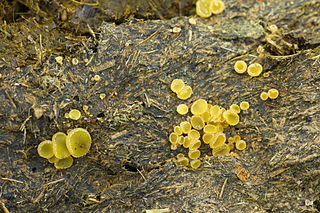
Coprophagia or coprophagy is the consumption of feces. The word is derived from the Ancient Greek κόπρος kópros "feces" and φαγεῖν phageîn "to eat". Coprophagy refers to many kinds of feces-eating, including eating feces of other species (heterospecifics), of other individuals (allocoprophagy), or one's own (autocoprophagy) – those once deposited or taken directly from the anus.

Conocybe is a genus of mushrooms with Conocybe tenera as the type species and at least 243 other species. There are at least 50 different species in North America.
The Sporormiaceae are a family of fungi in the order Pleosporales. Taxa have a cosmopolitan distribution and are saprobic on dung (coprophilous) and rotting vegetation.

The Ascobolaceae are a family of fungi in the order Pezizales. A 2008 estimate places 6 genera and 129 species in the family.

Coprophilous fungi are a type of saprobic fungi that grow on animal dung. The hardy spores of coprophilous species are unwittingly consumed by herbivores from vegetation, and are excreted along with the plant matter. The fungi then flourish in the feces, before releasing their spores to the surrounding area.
Tulosesus heterosetulosus is a species of mushroom producing fungus in the family Psathyrellaceae.
Polytolypa is a monotypic genus of fungus containing the single species Polytolypa hystricis. First classified in the Onygenaceae family, as of 2008 it is considered to be in the Ajellomycetaceae, although there is still uncertainty as to its phylogenetic relationships with other similar genera. This species is only known from a single specimen derived in the laboratory from a specimen of dung of the North American porcupine, Erethizon dorsatum, collected in Ontario, Canada. Polytolypa hystricis contains bioactive compounds that have antifungal activity.

George Edward Massee was an English mycologist, plant pathologist, and botanist.

Ascobolus is a genus of fungi in the Ascobolaceae family. The genus has a widespread distribution, and contains an estimated 61 species, most of which are coprophilous. The genus was circumscribed by Christian Hendrik Persoon in 1796.

Coprinopsis radiata, formerly known as Coprinus radiatus, and commonly known as the miniature woolly inky cap, is a coprophilous fungus that grows on herbivore dung. It is heterothallic.
Podospora appendiculata is a coprophilous fungus that is most commonly found in the dung of lagomorphs, such as hares and rabbits, in temperate to warm climates. A member of the division Ascomycota, P. appendiculata is characterized by ovoid, hair-studded perithecia which can bear a distinctive violaceous colouring and peridia which are coriaceous, or leathery, in texture. Podospora appendiculata has been shown to produce three compounds with antimicrobial properties.
Triangularia setosa is a member of the Ascomycota, and of the genus Triangularia. This genus is notable for its widespread appearance on the excrement of herbivores, and is therefore seen as a coprophilous fungus. The fungus itself is characteristically dark in colour and produces sac-like perithecium with a covering of hair. Its dispersion involves the ingestion, passage, and projectile ejection of spores. It has preference for colonizing the dung of lagomorphs, such as hares and rabbits.
Cercophora areolata is a member of the Ascomycota division, and is grouped into the Lasiosphaeriaceae family based on morphology. C. areolata is a coprophilous fungus that has been most recently isolated from porcupine dung. Defining features of C. areolata include: 1) ovoid-conical, glabrous ascomata, 2) black, carbonaceous, areolate peridium and 3) clavate-shaped, single-walled asci. From studies on C. areolata, this fungus produces multiple antifungal compounds, which inhibit other competitor fungi.

Dermatocarpon miniatum is a species of fungus belonging to the family Verrucariaceae.
Cercyon (Clinocercyon) lineolatus, is a species of water scavenger beetle found in several Oriental and Oceanian countries.
Ascobolus brantophilus is a species of coprophilous fungus in the family Ascobolaceae. It grows on goose droppings.
Lasiobolus lasioboloides is a species of coprophilous fungus in the family Ascodesmidaceae. It grows on the dung of sheep.

Coprinopsis nivea is a species of mushroom producing fungus in the family Psathyrellaceae. It is commonly known as the snowy inkcap.







